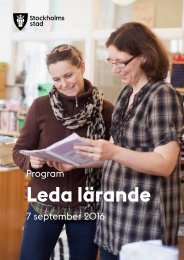FULLTEXT02
FULLTEXT02
FULLTEXT02
You also want an ePaper? Increase the reach of your titles
YUMPU automatically turns print PDFs into web optimized ePapers that Google loves.
supervisor’s learning developed according to Mezirow’s theory of transformative<br />
learning (Mezirow, 1991, 1996a, 1996b).<br />
The description of each supervisor's learning was completed with an<br />
analysis of what sort of supervisor competence developed (Lauvås &<br />
Handal, 1993) if there exists either gaps or conformity between thought<br />
and action, which is crucial to assessing how their supervisor competencies<br />
developed. There is a correlation between how supervisors think<br />
about themselves with what they actually do.<br />
The message of the ten supervisor portraits presented in study 2 can be<br />
summarized as follows:<br />
Supervisory pattern 1<br />
Four of the supervisors are characterized by the first pattern. They have<br />
developed critical thinking about themselves, their thinking and behavior.<br />
They are on the reflection levels 3 or 4. These supervisors lead conversations<br />
in a way that involves everyone in the group and makes the participants'<br />
thoughts visible to each other. Supervisors listen to participants<br />
statements and formulate further and deeper concerns. Questioning goes<br />
back and forth and tries to tie together thought and action. The way supervisors<br />
follow a supervision tradition of action and reflection make<br />
conversation patterns visible. In these cases, the supervisors have developed<br />
an emancipatory form of learning and they reflect critically on their<br />
manner of leading the talks. The supervisors have gotten hold of<br />
knowledge and experience in order to lead the educational conversations<br />
and can translate this knowledge capital into action. They have thus developed<br />
a good supervisor competence.<br />
Supervisory pattern 2<br />
The second pattern characterizes four of the supervisors. They also have<br />
developed a critical thinking about themselves and their ways of<br />
supervising. They are on reflection of levels 3 and 4. These supervisors<br />
lead the conversations by taking examples from their own experience and<br />
give tips and ideas as inspiration to the group. Guiding the conversation<br />
focuses on action, which hinders shifts between thought and action. The<br />
way these supervisors mentor is in line with a tradition among teachers<br />
and the conversations will be largely confirmatory. The conversations<br />
mostly resemble a discussion, where all participants talk at the same time<br />
without listening to each other. The supervisors have a hard time to<br />
switch the unstructured conversation and lead it back to focus on a<br />
certain issue. Supervisors' way of thinking suggests that they are aware of<br />
138





